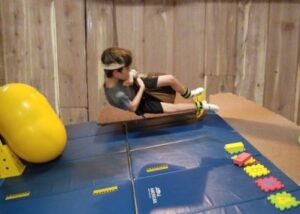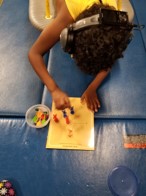
- Planning the steps
- Sequencing the steps
- Making mid-course corrections
Impacts math, handwriting, and reading skills
The term “motor coordination” generally refers to the ability to think through and carry out an activity that requires a series of movements. Meanwhile, the terms “Motor Planning” and “Motor Sequencing” refer to the ability to plan the moves and to carry them out in order.
Coordination of motor planning and sequencing skills work together to bring an intended series of moves through to completion. Underlying skills include attention to task, visual perceptual skills, and body awareness.

You can notice the intentional head tilt and eye gaze of this youngster as he swings in the direction of his target. You can also see that the boy is turning his entire body toward the target as he swings. This type of coordination also shows body awareness as he aligns his body to place the block onto the target.
Coordination of motor moves, including the ability to maintain focus and direction of a motor plan is needed for success in handwriting and math. For example, when drawing this word on a Smart Start sheet of paper, the motor plan calls for maintained focus upon the height and direction of the strokes for each letter. When attention and direction are not kept intact, the words change. In this case, the height of the tall line for the letter “T” was not kept, and the letter became a letter “i”. In a similar way, the height of the letter “h” was not kept, and the letter became an “n”. Lastly, the direction of the short line for the letter “e” was changed. Thus the letter became an “a”. Motor planning skills are a key feature for success in handwriting and reading skills.
Similar types of errors can impact math skills as well. For example, elementary school addition, subtraction, division and multiplication require intentional eye gaze and spacing in order to align numbers for math problems. Activities that involve coordination of motor planning and sequencing with intentional eye gaze can aid in development of these skills through “play”.

This youngster was able to use ”Sticky Darts” on a glossy dot-to-dot worksheet. He is shown in this photo wearing headphones to heighten his attention and working from a platform swing to arouse his level of coordination. The activity was designed to simulate his intentional eye gaze in order to place the Sticky Darts correctly. He enjoyed the activity so much that he asked if he could bring the darts home with him.
Activities that include motor coordination are helpful in terms of attention to task. Additionally, research has shown that when activities require motor planning and sequencing, they actually stimulate improved math and reading skills.
For further information, please see these posts:



Comments are closed.